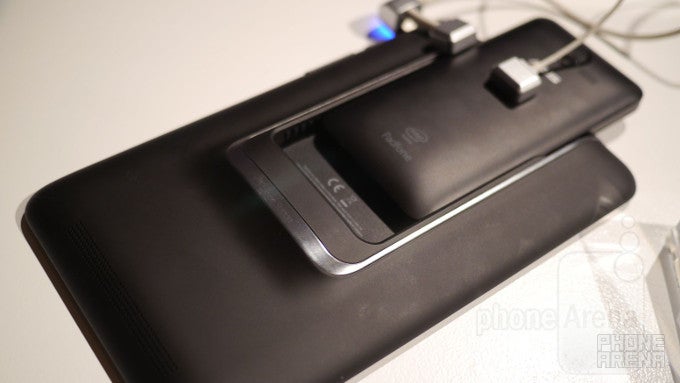Asus PadFone mini hands-on

Taiwanese Asus has made quite a splash at CES2014, introducing a bunch of new goodies at some seriously compelling prices. Case in point: the $249 PadFone mini -- a two-in-one kind of product, that combines a smartphone ("the brains") with a tablet dock. Said simply, you can dock the phone into the tablet whenever you feel like kicking back for a bit more immersive experience, or just use it standalone -- it really is up to you.
Design
The design of the PadFone mini shares common ground with that of the rest of the new Asus boys -- the ZenFones and, also, the bigger, more premium PadFone X. This means that we're treated to a soft-touch plastic rear that feels grippy and ergonomic in the hand, and up at the front: a metalic strip at the very bottom. This gives the phone a distinctive quality, despite its overall humble roots.Seeing as the phone is a part of a whole, it wasn't at all surprising to see that the tablet dock sports nearly identical looks -- the same soft-touch rear is present, and the overall shape and design of the tablet part clicks with that of the phone.
Lastly, Asus has announced five color options for the PadFone mini, which is always welcome news. Upon release, we should see units in black, white, yellow, red and blue made available.
Display
The PadFone mini is true to its name -- the diagonal on the phone measures just 4-inches, while the tablet clocks in at 7-inches. The frugality of the screen size carries onto the display tech itself, though, and to that end we're treated with a duo of TFT panels with a resolution of 480x800 pixels for the phone, and 800x1280 pixels for the tablet. These may not sound overly impressive in today's climate, but they still add up to an addequately sharp viewing experience.
Interface
The PadFone mini comes with a new interface based on Android 4.3 Jelly Bean, called ZenUI. In fact, all new Asus phones sport this new take on Google's OS, and we've gotta say that we liked what we saw -- a simplistic, minimal UI that said no to clutter. We obviously didn't have the chance to really dig into the new software, but, being quite familiar with most other manufacturers' skins, we've got to say that ZenUI actually felt like a good effort. The software is also very well-integrated between the two parts -- docking the phone seamlessly transfers whatever it was you were doing on the bigger screen, without glitches, at least during our hands-on.
Perhaps best of all, Asus does promise to follow-up quickly with an Android 4.4 KitKat update, which is still quite rare.
Processor and memory
Asus' relationship with Intel runs deep, for all new Asus products made use of an Intel heart. We're talking one of those dual-core Intel Atom Z2560 chipsets, clocked at 1.6GHz. We found no fault with the now aging chip -- performance felt buttery smooth, even on the tablet's big screen, which is just as it should be. 1GB of LPDDR2 RAM is also on-board, and you have 8GB of microSD-expandable internal storage to make use of.
Camera
The PadFone mini sports an 8-megapixel, Sony-made BSI unit with an aperture of f/2.0, but no flash. The company seems unconsciously aware of the omission, so it took any chance to talk-up its PixelMaster camera software, which, Asus promises, can help with the end results of low-light shots enormously. Of course, one does have to wonder just how much software can do in the absence of darkness, so we're not completely sold just yet.
Expectations
Much alike to the rest of the new Asus contingent, the PadFone mini is priced aggressively, and market share seems to be what the company is after. With a price tag of $249, the PadFone mini should prove quite the bundle for the budget-minded consumers out there, and it sure looks to be offering more value than its price would suggest.













Things that are NOT allowed: